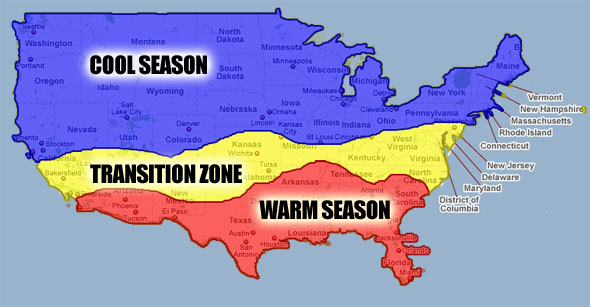 Home - Garden
Home - Garden
How To Care for your Lawn at HowToDoThings.com
Grass Types:

Source: Types of Grass @ LawnCareGuide.com
Cool Season: Bentgrass, Kentucky Bluegrass, Rough Bluegrass, Red Fescue, Annual Ryegrass, Perennial Ryegrass
Transition: Kentucky Bluegrass, Tall Fescue, Perennial Ryegrass, Thermal Blue, Zoysiagrass
Warm Season: Bahia, Bermudagrass, Buffalograss, Carpetgrass, Centipede, St. Augustinegrass, Zoysiagrass
See also: Grass types @ american-lawns.com
Fertilize :
New Jersey: Fertilize in late may, early september and 1st week of november. avoid fertilizer during hot summer months. These 3 times are the most important for us in New Jersey.
At Lawn Care in NJ: Seasonal Calendar | Borst Landscape says,
"Early to mid-March is a great time to fertilize your lawn. Keep it light and use a slow-release or organic fertilizer.
pH :
a soil pH between 6.0 and 7.0 (slightly acidic) is ideal.
See:
Lime And The Home Lawn, HYG-4026-90 OSU.edu
Liming the Lawn WVU.edu
Mowing:
Studies show that this causes less stress to the grass plant than heavy, infrequent cuttings. The general rule is cut no more than 1/3 of the grass blade at any one cutting. Otherwise the grass is deprived of too much of its energy-storing foliage and has to devote its resources to rapidly replacing the foliage at the expense of root development.
Clippings do not cause thatch.
Leave Clippings To Fertilize - When you leave the clippings to decompose on the lawn as you mow all season, they provide 25% of your lawn's annual nitrogen requirement.
Leave Clippings To Mulch - Left on the lawn, grass clippings serve as a temporary mulch, blocking the evaporation of moisture from the soil.
Leave Clippings To Save Time - It takes 30% less time to mow a lawn and leave the clippings than it does to go to the trouble of collecting and bagging those clippings.
Don't mow grass with a dull mower blade.
Some sites say to mulch with your last mowing. Mow right over a 1/2 inch or so of fallen leaves for your final mowing in the fall. With the help of soil organisms they will decompose among the grass blades over the winter, adding organic material to the soil.
See:. (ExtremelyGreen.com/lawncareguide.cfm)
Mowing Height:
Tall Grass Has Fewer Weeds - Routinely mowing northern turfgrasses to a minimum of 2 inches high reduces weeds 10 fold over mowing 1 inch high because the longer blades block the sun that ever-present weed seeds in the soil need to germinate. Set the mower at about 1 1/2 to 2 inches (for Bluegrass-Fescue lawns) then gradually raise it to 3 inches by early June and for the rest of the season.
Summer: 3-3.5 on non irrigated. 2.5 to 3 on irrigated. tall fescue 2 - 4" fine fescue 1 1/2 - 2 1/2 Bluegrass 2 - 3 RYE 1 1/2 - 2 1/2 (some sites show lower heights, but higher heights reduce weeds) Spring First cut of the spring should be low (1 1/2 - 2".) Fall 2.5" final 2" for cool-season grasses - 1" for warm-season grasses
Last several cuts of the season, start cutting lower (down to 1 inch for perennial ryegrass and fine fescue, 2 inches for kentucky bluegrass and tall fescue).
See: Lawn Mowing, HYG-4020-93 at Ohio State
Watering - Irrigation:
See Lawn Watering
Watering Timers
Aeration:
If you have cool-season grasses , aerate in the fall. Lawn aeration for warm-season grasses is usually best done in the springtime.
Soil temperature is the best indication of when to aerate. Studies have shown that for cool season grasses in particular, soil temperatures in the 50 - 65 degree range is the ideal time to aerate a lawn.
Links:
Lawns, Lawn & Landscape, Lawn & Garden - UC Agriculture and Natural Resources (ANR) Catalog
Aeration and Aerating A Lawn
Kill Lawn for Drought Resistant yard
Links:
Problems - Weeds - Pests - Fungus